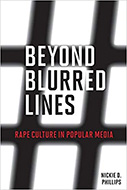Beyond Blurred Lines: Rape Culture In Popular Media

Author: Nickie D. Phillips
Publisher: Lanham, MD: Rowman & Littlefield, 2017. 306p.
Reviewer: Elizabeth Twitty | March 2020
We currently live in a media-dominated society, where the dissemination of information is combined with the sharing of images and discourse about a variety of topics. As such, the concept of rape culture, a term originating in academia addressing the normalization of sexual violence within society, has made its way into mainstream and social media. The increase in critiques and open discussion of sexual violence and rape culture have contributed to a greater social understanding of sexual violence, inequality, and rape myth acceptance. Concurrently, there were critics of the term, claiming that the concern over rape culture was simply a moral panic, much like the Satanic cult and child sacrifice panic of the 1980s. In Beyond Blurred Lines, Nickie D. Phillips documents the rise of the concept of rape culture, its use in popular culture and societal spaces such as gaming and college campuses, and how this ultimately shapes attitudes and responses to sexual violence.
The author uses a cultural criminological framework to show how the concept of rape culture entered public spaces, particularly through media, and how the subsequent discourse then impacts politics and policy making. Chapter 1 introduces the definition of rape culture and the subsequent backlash against its usage in certain spaces such as the entertainment industry, politics, academia, and the criminal justice system. Further, the author provides readers with examples of what constitutes rape culture, such as gender role assumptions, victim-blaming attitudes, and the objectification of women in the media. Phillips also tracks the use of the term “rape culture” in media since the 1980s, and compares that with rates of sexual violence globally and in the United States.
Chapter 2 provides three examples – a Steubenville, Ohio rape case; the infamous New Delhi, India gang rape; and the success of Robin Thicke’s song “Blurred Lines” – to examine the mainstreaming of rape culture. These particular cases analyze rape culture and its awareness on domestic, international, and popular culture levels. Subsequently, this mainstreaming, as the author argues, led to a greater awareness of the concept of rape culture, but the author also highlights that this understanding was primarily based on popular culture’s representation and sensationalism.
Chapter 3 focuses on television in its perpetuation of rape culture and analyzes what constitutes good and bad representations of the reality of rape. For example, the author uses the highly popular show Game of Thrones to provide examples of how sexual violence is often included in story lines to liven up the plot. In this argument, the author highlights how sexual violence is often included simply for shock value and fails to use this opportunity to discuss further implications of the prevalence of rape, underreporting, and victim treatment. In addition, this chapter examines how audiences respond to depictions of rape, arguing that individuals process these scenes according to how they made them feel and think, whether being repulsed or attracted to images of sexual violence.
Chapter 4 examines the misogyny present in “geek spaces,” particularly gaming communities, in how female characters are portrayed in games as well as the experiences of women working in the industry. For instance, female characters are often hypersexualized and used as props rather than as actual characters you can play. Furthermore, female gamers experienced backlash from other gamers claiming that they were simply “pretty girls who pretended to be geeks for attention.” This use of hypersexuality and exclusion in the gaming community serves to encourage rape culture in the form of misogynistic comments towards female gamers and women working in the gaming industry. The author argues that these practices and messages in the gaming community ignore the larger cultural context of abuse and harassment while simultaneously proclaiming that women simply do not belong.
Chapter 5 looks at another facet of so called “geek spaces”: comic book culture. The author argues that the comic book space is full of contradictions; there are many progressive creators who work to be inclusive, but the industry is also criticized for falling short on diversity and relying on violence for entertainment. In discussing female portrayals, these characters are often hypersexualized and frequently subjected to violence. As seen in the previous chapters, the author’s argument about sexual violence in comic books is that this hypersexualization of women promotes rape culture and misogyny, and the use of violence is simply used to liven the plot without further examining the societal implications. Furthermore, when women are the central characters, rape is often used as a backstory, making their victimhood their defining characteristic. Finally, this chapter includes a discussion on workplace harassment in comic book culture. In these workspaces, complaints or criticisms of a lack of diversity, representation, and harassment are often met with hostility. Opponents of these claims (who may indeed be the ones perpetuating these actions) have argued that these criticisms stem from hypersensitivity and a larger social justice agenda, while also stating that their creativity is being infringed upon. Therefore, complaints are often shrugged off and scoffed at rather than being taken seriously.
These themes continue into Chapter 6, where the main focus is on rape culture on college campuses. The central point of many documentaries and policies, the college campus has been touted as a cesspool of sexual violence. This chapter examines the policies and debates that have surrounded sexual assault on campus, highlighting high-profile incidents, attention to false allegations, and the shift in focus from victims to the accused. While making strides in the processing of sexual assault allegations, the college campus has also been linked to concerns about hypersensitivity, political correctness, mockery of safe spaces, and claims of censorship. Thus, while claims have begun to be taken seriously, this linkage to other critical concerns has led to the sexual assault rape culture being misappropriated and used against itself.
Chapter 7 addresses current policy and its insufficiency in assisting victims, especially when injustices occur in politics and the criminal justice system. As such, the author argues for more innovative approaches, focusing on restorative justice and cultural shifts in attitudes about sexual violence. In sum, Phillips provides an examination of rape culture across multiple formats, including public discourse. Beyond Blurred Lines is a guide map for examining gender inequality and the presence of hegemonic masculinity, rape myth acceptance, and victim blaming.
While this monograph is instrumental in mapping out the ways in which victim blaming and rape culture have become popularized through mainstream popular culture, there are some minor issues with it. First, the book could have benefitted from including visual images of the chosen case examples when discussing rape culture. For instance, the author draws upon television, video games, and comic books for visual indicators of sexual violence, but does not include these representations in any visual way. As a reader unfamiliar with gaming and comic book culture, I found myself having to stop reading and search for the examples the author referenced. Including small images, such as the comic book covers or examples of hypersexualized video game characters, would have bolstered the author’s argument and made more sense for readers unfamiliar with that particular media format. In the event that including these images was not possible because of copyright restrictions or high licensing costs, richly detailed descriptions in the text also would have alleviated this issue.
Secondly, the final chapter, Reconciling Panic and Policy, concludes the author’s arguments about how rape culture and sexual assault epidemics have become contested in mainstream, academic, and political debate. This discussion is an imperative topic to end on, highlighting that there is little consensus across even ‘professional’ settings about the prevalence of sexual violence and gender inequality and the importance of addressing these societal ills. However, the chapter suffers by not providing specific, clear policy implications. Rather, the chapter gives the impression that reforming rape culture is purely theoretical and fantasy, not having any concrete directions. Previous researchers have indicated that legal reform alone is insufficient to address sexual assault and the treatment of rape issues; rather, a change in attitude and perception is also needed. While I agree with this statement, the author could have made some solid recommendations with regard to restorative justice, mediation, education, etc. These policy implications aside, the author does discuss the need to move away from draconian policies, such as incarceration. This point is well-made by the author, but then she goes on to discuss sexual assault on college campuses and offers no alternative solutions.
Taken together, Beyond Blurred Lines provides readers with a frank discussion of rape culture and depictions of sexual violence in popular media. Using multiple media formats appeals to a wide audience and provides a plethora of examples through which misogyny has endured. Even if some readers were unfamiliar with certain issues, Phillips’ use of context allows readers to follow her argument throughout the book. Furthermore, the inclusion of tweets, article headlines, and social media comments brilliantly portrayed the extent of rape culture in mainstream discourse. The integration of fictional representations of sexual violence and treatment of victims (Game of Thrones, Law and Order, and The Walking Dead), contrasting with real life cases and their aftermath (Steubenville, New Delhi, campus assaults), is especially powerful, allowing readers to distinguish between the two and see the ubiquity of sexual violence, rape myth acceptance, and victim blaming attitudes. Beyond Blurred Lines is a significant contribution to the field of violence against women and is extremely relevant in our current mediated society.
Elizabeth F. Twitty, Doctoral Candidate, Old Dominion University


